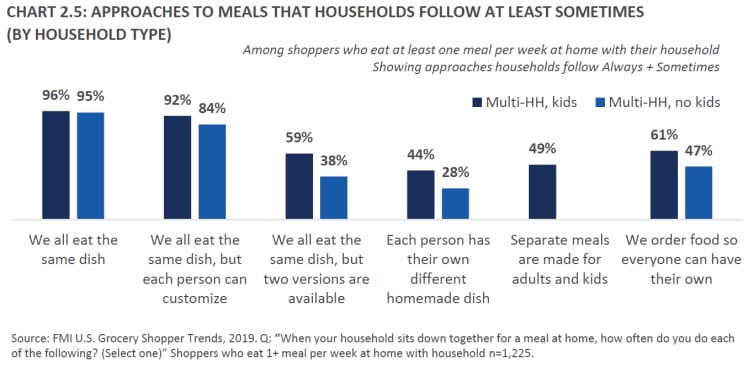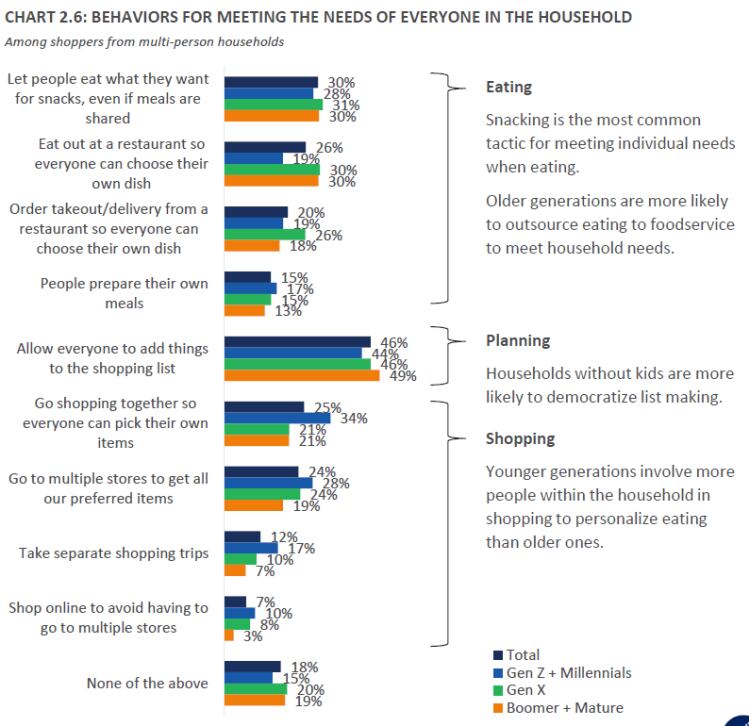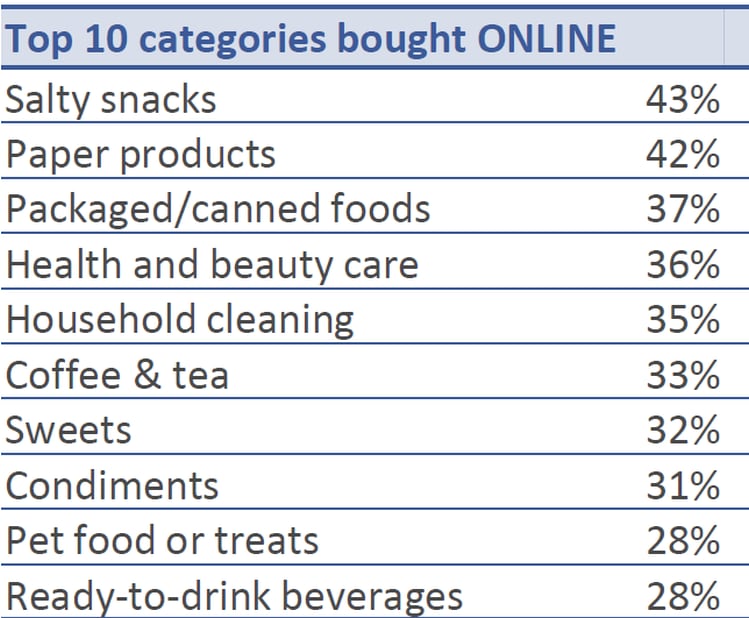1 – Eating alone
US households enjoy shared breakfasts and lunches only about twice a week and 1.5x per week, respectively, but share dinner slightly more often (3.6x a week).
2 - ‘Individualized’ eating
One-third of households have at least one member voluntarily following at least one dietary approach (keto, paleo, vegetarian etc), with key drivers for customized meal options within households including individual taste preferences, diet regimes, ethical issues, religious issues, and cultural issues.
3 - Boomers and millennials look for different claims on pack
Boomers and older generations are more likely to look for low-sugar, low-sodium, low-fat, high-fiber, and low-carb claims; whereas millennials and gen Z shoppers are more likely to look for natural, free-range, certified humane, and gluten-free claims.
4 – Grocery shopping frequency hasn’t really changed
While several trends are pushing consumers towards more frequent grocery shopping trips (a reduced planning horizon for eating, a constant-shopping mentality, urbanization, and a desire for freshness), other factors are pushing them in the opposite direction (a migration to online for fill-in or stock-up, increased reliance on foodservice, and more ad-hoc food purchases outside of trips dedicated to groceries).
5 – The average grocery shopper shops at 4.4 retailers
As for variety, the average grocery shopper shops at 4.4 retailers, a figure that hasn’t changed much in recent years.
6 – One in 10 shoppers has subscribed to a meal kit service in the past 12 months
One in 10 US shoppers has subscribed online to a meal kit delivery service at some point in the last 12 months (vs. 5% in 2018), with men adopting them at a higher rate than women (12% vs. 8%).
7– Urban, affluent, male, college-educated…? Online shopping demographics
33% of Americans shop at online-only grocery retailers “at least occasionally” (up from 28% in 2018 and 16% in 2015).
Compared to shoppers overall, frequent online grocery shoppers are more likely to be male; in the millennial or gen Z age range; parents; college-educated; with household income above $100k; and urban.
However, reach among Millennials has not grown in the last two years, suggesting that after Gen X and Z catch up, the online user base may soon plateau, predicts Hartman Group.
8 – Are women still more likely to be primary grocery shoppers?
While women continue to be more intimately involved with shopping responsibilities, 53% of regular male food shoppers now claim to be their household’s sole or primary shopper, notes Hartman Group. “The presence of children often forces a divide and conquer strategy, resulting in a higher incidence of primary shoppers compared to multi person households without children.”
9 – Primary stores vary by generation
58% of boomers and mature shoppers name a supermarket as their primary store for groceries, compared to just 43% of gen X and younger shoppers. Gen Xers turn to supercenters more often than any other generation, while all three younger generations (gen Z, millennials, gen X) look to limited assortment stores (such as Trader Joe's, Aldi) and online more often than boomers.
10 – Shopping priorities vary by generation
When they shop, millennials and gen Z shoppers are more likely than boomers to place value on nutrition and health information available; locally grown products; private label; customer service that feels personalized; a good selection of natural/organic products; easy, grab & go fresh prepared foods; an exciting environment to browse ideas/products; the provision of information beyond the package; self-checkout; recycling / sustainability practices; a good selection of ethnic or cultural foods; pay via smartphone options; online ordering for pickup and online ordering for delivery.
25% of shoppers say they use a grocery shopping app provided by their store.
* The 2019 Food Marketing Institute US Grocery Shopping Trends study was conducted by The Hartman Group, using qualitative and quantitative data collection including one-on-one interviews with shoppers in Seattle, virtual interviews with shoppers across the nation, and online questionnaires with 1,786 US primary shoppers aged 18+.




